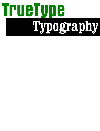
N.B. An asterisk before a word means it has its own entry in the glossary.
- T2K
-
A new font rasterizer - suitable for embedding in all sorts of devices - by Type Solutions' Sampo Kaasila. (He's the inventor of TrueType.) As well as doing a very good job on TrueType and Type 1 fonts without even looking at the hints, it has its own highly efficient (and hintable) outline format. Sample renderings, a downloadable demo and more information are at the Type Solutions website.
In early 1998, Sun licensed T2K for use in future Java libraries. - transformation matrix
-
Two-by-two matrices are used at several stages in TrueType fonts. First is the transformation decided by point-size, the device and the *resolution. (Remember some devices have non-square pixels.) Second is the transformation given by the current zoom ratio, and any rotations, shears or reflections. Third is the transformation associated with components of *composite *glyphs (which also have x and y offsets). Unfortunately Microsoft coded this last transformation wrongly in Windows 3.1 - only simple reflections worked. Windows 95 and NT4 got it almost right... the word is they'll soon converge back on the original Apple method.
That transformation matrices are used so extensively relies on a very useful propery of *Bézier curves - that by simply transforming the control points of a curve by a certain matrix, the resulting curve is exactly as though every point on the curve was transformed by that same matrix. Note that the same is not true for circular, elliptical or spiral curve descriptions. - TrueDoc
-
A technology invented by Bitstream for "recording" fonts and "playing them back" over the Internet so that visitors to a website see all text in the original fonts. Since the "recordings" of fonts - sent over the internet to any visitor to a website - contain font outlines, many type designers are wary of this technology due to the risk of piracy. There's an official TrueDoc website.
- TrueImage
-
A still-born PostScript-compatible graphics system, cross-licensed in exchange for TrueType by Microsoft to an ill-advised Apple.
- TTC
-
TrueType Collection file. A scheme where multiple TrueType fonts can be stored in a single file, typically used when only a subset of glyphs changes among different designs. They're used in Japanese fonts, where the Kana glyphs change but the Kanji remain the same.
- TTF
-
The recommended file extension for TrueType font files on the PC. On the Macintosh, exactly the same data is in an *'sfnt' resource.
The recommended file extension for the TrueType flavour of *OpenType fonts is also TTF. (But Type 1 flavour OpenType fonts should have an OTF extension.) - TTFDUMP
-
A utility for dumping the contents of a TrueType font into a text file. It's freely available from Microsoft's TrueType tools page. Runs from the DOS command line.
- Twilight Zone
-
The set of points that, in TrueType hinting, can be used as reference points by glyph programs and the *preprogram. They are not attached to any particular *glyph. Often key Twilight Points (such as one placed on the cap height) are set in the preprogram. However, many font hinting engineers don't bother with Twilight Points.
- Type 42
-
Type 42 fonts are TrueType fonts with a rather trivial PostScript "wrapper", as described in Adobe's Type 42 specification, in PDF format. Many PostScript Level 2 printers have a built-in TrueType *rasterizer - these TrueType fonts must be downloaded as Type 42.
- typeface
-
I expect you're looking for a clear definition of "typeface" as opposed to *"font". Unfortunately, there isn't one.
- TypeMan
-
A professional tool for TrueType *hinting, developed by Type Solutions' Sampo Kaasila (who is also TrueType's inventor). Although you can code directly in TrueType instructions if you wish, TypeMan's main advantage is that you can code in its higher level language, *TypeMan Talk. Microsoft's hinting tool, *Visual TrueType, is based on TypeMan.
More recently TypeMan has become Visual TypeMan, where hints are drawn on the screen, and the Talk language is hidden from the user. TypeMan has only ever been released on the Mac. - TypeMan Talk
-
The language developed by Type Solutions to make TrueType *hinting more user-friendly, and first used in the *TypeMan program. Commands in the language are very closely related to native TrueType, so an efficient Talk program compiles to an efficient native TrueType program. But you don't need to worry about the *stack, or certain variables in the *graphics state. *Visual TrueType also uses the language.
TYPE*chimérique | TrueType Typography | TYPE*links